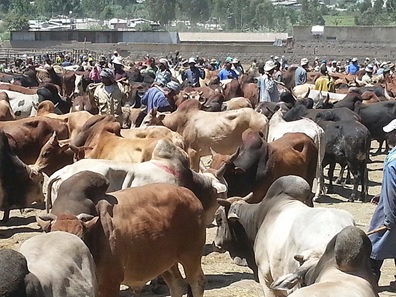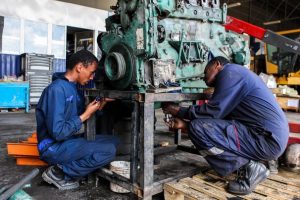
The livestock subsector is one of the fastest-growing economic sectors in developing countries like Ethiopia. Demand for animal source foods is growing rapidly, fuelled by population growth, urbanization and rising incomes. This offers huge opportunities for the livestock sector and people who keep animals but also poses some challenges that cannot be ignored.
Keeping this in kind, The Ethiopian Herald conducted an exclusive interview with Abebe Tolcha, an agriculturalist graduated from Haramaya University, to have a piece of information about the significance of livestock or animal husbandry and its contribution to economic progress as well as its demerits, if any.
As to Abebe, animal husbandry (the practice of taking care of livestock), an important component of agriculture, is also a pillar industry that supports the survival and development of farmers and herdsmen thereby pushing the agriculture sector steps forward. The animal husbandry industry accounts for about half of the global agricultural economy and makes important contributions to global food security.
It is essential to explore the driving factors that influence the development of animal husbandry and their effects on the animal husbandry economy in order to adapt to and mitigate the impact of global changes in economic development, he stated.
He said, “Livestock (animals themselves) are important to the livelihoods of a large percentage of rural women, men and children living in poverty. They play a number of different roles, from income generation and the provision of inputs into mixed cropping systems to providing a buffer against environmental and economic shocks.”
According to Abebe, policy-makers need to consider the multiple roles of livestock in the livelihoods and food security of the poor. Smallholders need support in order to take advantage of the opportunities provided by an expanding livestock sector and to manage the risks associated with increasing competition and closer linkages with modern value chains.
He further stated that livestock production is a major contributor to economic growth, providing food, income, and jobs. It also helps to improve nutrition and gender equality.
He said, “It is crystal clear that livestock production can potentially contribute a lot to economic growth in terms of income generation, employment opportunity, foreign exchange, addressing food safety issues and ecological wellbeing.”
As far as the issue of income is concerned, livestock production provides income for herders, veterinarians, and slaughterhouse workers, and livestock production creates jobs in the agriculture, processing, and distribution sectors, in the case of employment as well as it provides people with nutritious food, such as meat and dairy, as well, he added.
When we talk about the case of foreign exchange, he said the subsector is of paramount importance in contributing a great deal to a country’s foreign exchange earnings. However, making all these contributions could never be on a rosy path as livestock production can impact economic growth negatively as it can cause, unless properly handled, environmental degradation and other related aspects.
One of the key opportunities for reducing challenges of livestock in our country is through increasing productivity. With the right policies and investments, livestock could accelerate food systems transition across the nation and help feed a fast-growing population in a healthy manner, especially young women and children, while respecting the environment and providing job opportunities for those who need them.
Policymakers and investors he said should consider supporting the farming community and they should also consider ways to increase the supply of animal source foods without negatively impacting economic growth. Besides, with technology, investment and the right policies, livestock can contribute fully to food security and nutrition, health and economic development while at the same time respecting planetary boundaries and contributing positively to the environment and social and gender equality.
As to Abebe, livestock-derived foods can play an essential role in reducing levels of malnutrition, for they are nutrient-dense, providing rich and diverse essential micronutrients, especially for those often most vulnerable including poor rural women and children. Stunting in children is not just physical, but affects cognitive development, learning ability and social development.
Yes, he said livestock provides many other benefits, including income generation, draught power, transport, manure to enhance soil nutrients, social security, and insurance in times of need. At least half of the staple cereals underpinning food security in Africa, for example, can only be produced because livestock are integral, providing income, animal power and manure.
He said, “Livestock can also provide business and employment opportunities, not just in production, but all along the value chains especially for young people and women. Yes, the subsector is one of the fastest growing segments of the agricultural economy, particularly in the developing world like Africa, centering Ethiopia. As demand for meat and dairy products continues to increase, questions arise as to how this demand will be met and by whom.
To date, the transformation of the livestock sector has occurred largely in the absence of sector-specific policies; this gap needs to be addressed to ensure that the livestock sector contributes to equitable and sustainable development. In addition to this, livestock can provide income, quality food, fuel, draught power, building material and fertilizer, thus contributing to household livelihood, food security and nutrition.”
Strong demand for animal-based foods and increasingly complex processing and marketing systems offer significant opportunities for growth and poverty reduction at every stage in the value chain. These new market opportunities and livelihood options face rapidly changing patterns of competition, consumer preferences and market standards. Policy reforms, institutional support and public and private investments are urgently needed with a view to assisting those smallholders who can compete in the new markets, easing the transition of those who will exit the sector, and protecting the crucial safety-net function performed by livestock for the most vulnerable households.
He said, “The livestock sector is central to food security, not only for rural smallholders who rely directly on livestock for food, incomes and services, but also for urban consumers, who benefit from affordable high-quality animal-based food. Livestock play an important role in all four main dimensions of food security: availability, access, stability and utilization. The extent to which nutrition is improved depends on whether increases in income create more diverse diets. In the long run, there is an established connection between income growth and improved nutrition.
However, in the short run, policy interventions may be necessary to promote increased consumption of foods of animal origin in the diets of the poor.”
The subsector contributes directly to food availability and access for smallholders, often in complex ways. Livestock also provide draught power, fertilizer and pest control in mixed farming systems, contributing to total farm productivity and hence to food security. The fourth dimension of food security – utilization – is particularly relevant in the case of livestock and animal-based foods, he added.
As to him, foods of animal origin can provide high-quality protein and a variety of micronutrients that are difficult to obtain in adequate quantities from foods of plant origin alone.
Better access to foods of animal origin through the promotion of livestock together with nutrition education can thus be considered a strategic intervention for avoiding the poverty–micronutrient– malnutrition trap. The costs for developing countries that have to face this double burden of malnutrition are large. The human and financial costs of prevention and treatment of obesity and non-communicable diseases are high and place huge strains on existing health care systems. Livestock products are processed and marketed largely through informal systems.
Abebe at last summed up that pastoralist populations, traditional herders support subsistence livelihoods and sell live animals through local markets. In the most rapidly growing economies, smaller-scale livestock producers, especially of cattle, poultry and apiculture have to be well capitalized on as these help farmers do away with subsistence life leading. Significant and sustained innovation in national, regional, continental and even global food and agricultural systems will be required in order to support rural development.
In the case of livestock, the notion of capacity for innovation needs to be expanded to encompass the complex set of activities, players and policies involved in developing, accessing and using knowledge and technology for agriculture and food-system innovation. Innovations in livestock production, processing, utilization and distribution usually take place where different players in the sector are well networked together, allowing them to make creative use of ideas, technologies and information from different sources, including swift schmoosing.
BY MENGESHA AMARE
THE ETHIOPIAN HERALD FRIDAY 28 MARCH 2025





